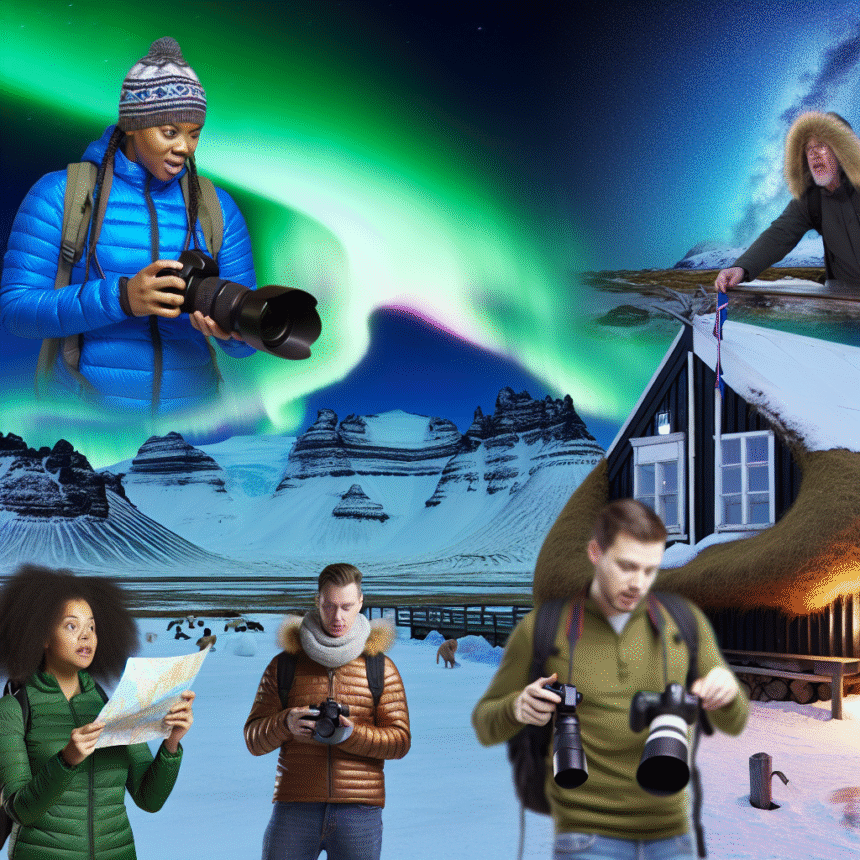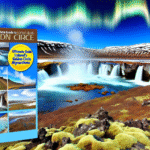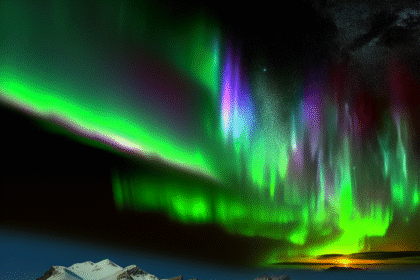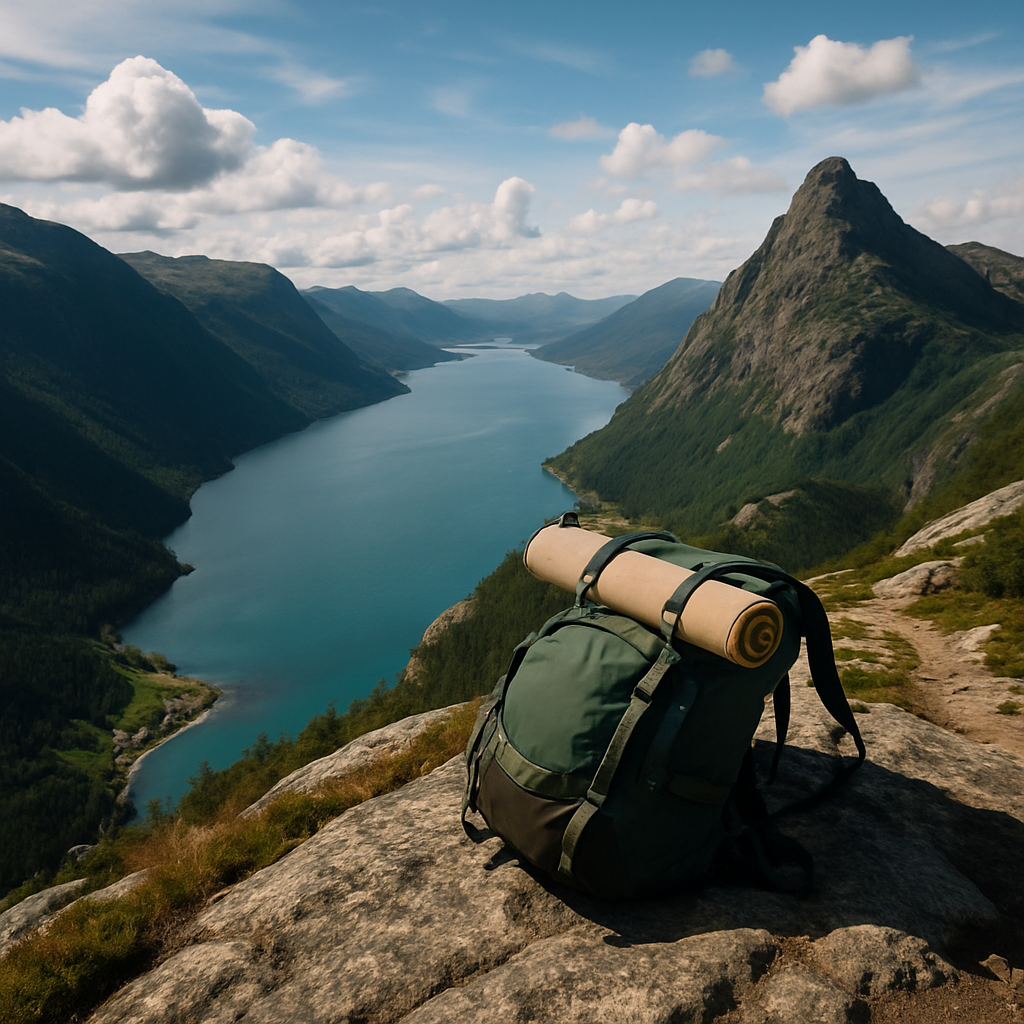There’s something mischievously magnetic about North Iceland in winter (must be a 66 degrees north kind of thing). It’s the type of place that makes you forget schedules, TikTok videos, and why you ever wore anything but thermal layers (in winter, mind). The snow settles like icing sugar over volcanic hills, the Aurora pirouettes across the sky, and the roads are an adventure all in themselves (Arctic Coast Way, anyone?) Treat this seven‑day itinerary as your ticket to Iceland’s lesser-seen side, full of wild beauty, and with none of the tour‑bus tedium.
Why North Iceland Deserves Its Own Road Trip
If you think Iceland begins and ends with Reykjavik’s bars and the Golden Circle’s selfie queues (assuming this reference will age well), brace yourself for revelation. In my opinion, North Iceland is where the real adventure begins. The waterfalls are bigger, the whales sightings are more common (best in summer under the Midnight Sun), and the Northern Lights occasionally put on such a show you’ll swear they’re just showing off (and more commonly vertical above your head). There are also lava fields that sleep under blankets of snow in winter, sleepy fishing villages that cling to the edges of fjords (we’ll get to them), and every bend in the road feels like the start of a proper expedition.
The north isn’t polished for mass tourism. It’s rugged, a little unpredictable, and absolutely brilliant for it (and, if I’m honest, Iceland just doesn’t market it anywhere near enough). It’s also wildly diverse with a combination of volcanic craters beside thermal lagoons, Arctic wildlife mingling with myth, and a sense of isolation that’s more liberating than lonely (plus the elf capital is here at Ásbyrgi Canyon). Some of the roads might close without warning, but that’s part of the fun; Iceland’s winter demands flexibility and rewards those who travel with curiosity and caution in equal measure.
The best way to explore, of course, is in a one of your campers, naturally. Your bed, heater, and kitchen all travel with you, providing a portable cocoon of warmth against the Arctic chill. Park beside the the tip of Húsavík, sip hot chocolate while the Aurora flickers overhead, and discover how a campervan turns Iceland’s fierce wilderness into your own cosy living room on wheels (and also our team are nice and provide plenty of extra for free, just saying).
How to Get to North Iceland (and What You’ll Need)
Most of our travellers start in Reykjavik. Or as I see it, the land of good coffee, street art, and questionable parking (and I’m talking about the locals here). From there, you’ve got two solid options: take the scenic Ring Road north (roughly 5–6 hours to Akureyri if you behave yourself), or hop on a quick domestic flight to Akureyri in under an hour (but, that’s not fun, is it?) The road trip is worth every kilometre, though, especially if you’re cruising in your campervan straight from the capital. Along the way, you’ll pass steaming rivers, mossy lava fields, and a series of sleepy coastal towns such as Hvammstangi, the home home fo seals (not the singer), on the Vatnsnes peninsula.
Before starting your trip, stock up on essentials in Reykjavik. Supermarkets like Bónus and Krónan are often cheaper there than small-town shops up north (and gas station selections can be questionably random). Fill your camper with groceries, a full tank, and perhaps a cheeky pastry or two from Brauð & Co. Winter daylight is short, so plan your driving hours wisely. It’s best to travel between 10am and 4pm in the depths of winter, when the sun makes its brief but glorious appearance.
Pack for everything. Winter in Iceland is like a toddler with an iPhone, chirpy and pleasant one moment, furious the next. You’ll need base layers, waterproofs, thick socks, and gloves that you can use to take photos. Don’t forget a decent playlist (our team can recommend some questionable cosmopolitan tracks), and snacks for those inevitable “but Google maps said 5 minutes” detours.
The Ultimate 7-Day North Iceland Itinerary
Before diving into the day-by-day plan, here’s what you’re in for. This isn’t your average tick-box itinerary, it’s a road trip for those who prefer thermals over tour buses (translation: for those with good taste). You should expect long stretches of scenic solitude, plenty of alluring roadside stop-offs (definately check out Grabrok crater near Bífrost), and the kind of silence you can actually hear. Each day builds on the last, weaving through Iceland’s northern wilds where weather, whim, and a campervan heater set the rhythm.
Day 1, Reykjavik to Akureyri: The Long Road North
Set off early, armed with caffeine, curiosity, and a healthy respect for Iceland’s unpredictable weather. The Ring Road north is a cinematic journey through an ever‑changing landscape of lava plains, glacial rivers, and snow‑blanketed valleys in winter where lonely farmhouses glow like lanterns in the distance.
You’ll want to pull over often, not just to stretch your legs, but to marvel at the sheer emptiness of it all. There’s a special kind of peace that comes from watching the morning mist drift across the moss‑covered lava fields while the only sound is the crunch of snow under your boots (and tyres).
I suggest you break up the drive at Borgarfjörður, where you can warm your bones in Deildartunguhver’s steamy geothermal waters at Krauma spa, the hottest springs in Europe. Or detour to Hvítserkur on the Vatsnes peninsula to check out the traditional rock elephant/dragon (one of two in Iceland, believe it or not). The legendary dragon‑shaped (I still more see an elephant) sea stack that looks as though it’s frozen mid‑snarl (drink). If the weather’s calm, linger awhile; the contrast of ice, surf, and volcanic rock makes for unforgettable photos. But, be aware, that Iceland from time to time does indeed get stranded Polar Bears who have drifted on lost icebergs, and one was reported to be on this very beach many years ago (no one was harmed).
Then continue further, perhaps pausing at roadside cafés in Blönduós or Varmahlíð for a steaming bowl of lamb soup, which is classic winter staple that tastes like a hug in a mug (bowl). Keep an eye on Road.is for conditions; blizzards can arrive without RSVP, and mountain passes often close when the weather decides today is the day it really wants attention.
By late afternoon, you’ll roll into Akureyri, Iceland’s second city (though locals insist it’s first in personality). The lights twinkle against the fjord, the air smells faintly of woodsmoke, and after a day of wandering through the nature, it feels positively metropolitan. Park your campervan along the waterfront, whip up a comforting dinner, and settle in for your first night under the Arctic sky. With luck, the Northern Lights will ripple over Eyjafjörður as your official welcome gift from the north (not in summer, of course, but you knew that).
Day 2, Akureyri: Iceland’s Coolest Little City
Akureyri is like Reykjavik’s cooler cousin. It’s smaller, friendlier, and infinitely less pretentious. It’s a town that thrives on charm rather than spectacle, where colourful houses hug the fjord and snow-capped peaks frame every photo.
I recommend you start your morning with a sticky caramel Snúður and strong coffee at Kaffi Ilmur, then wander down to the old town to admire 19th-century timber buildings, quirky street art, and the more smiley population. For a warm-up, head to the city’s Forest Lagoon. And yes, even when it’s minus five, the steam rising against the mountain backdrop is pure therapy.
Akureyri also punches above its weight culturally. Pop into the Akureyri Art Museum, peek into the iconic red-roofed church (Akureyrarkirkja), or browse local crafts in boutiques along Hafnarstræti.
If you’re feeling active, why not try the slopes at nearby Hlíðarfjall Ski Resort, which is easily one of the best in Iceland and just minutes from downtown (plus the views even from the car park are worth the jaunt). Afterwards, the harbour beckons for a whale-watching tour. Even in the depths of winter, humpbacks, minke whales, and the occasional orca frequent the fjord, surfacing through misty waves as if to remind you that nature runs the show here (I was there a few months ago and saw so many breaching Humpbacks).
Before you decide to head east, stock up on the essentials: food, fuel, and a hefty dose of patience for the snowy roads ahead. Supermarkets, bakeries, and petrol stations are plentiful here, so this is your last proper supply stop for a hundred kilometres. There’s something delightfully cosy about falling asleep in your heated camper with Akureyri’s twinkling lights reflected in the fjord outside, and in winter it’s even better (insdier tip: Cafe Berlin does a belter of a brunch menu).
Day 3, Mývatn: Geothermal Marvels and Martian Landscapes
Leave civilisation behind and drive to Mývatn, a geothermal wonderland complete with bubbling earth, steaming vents, and spectacular sunsets. The approach alone is an event: frozen lava fields glint beneath snowdrifts, and the faint scent of sulphur creeps through the crisp air as you near the lake’s steaming shoreline. Mývatn is a hub of geothermal activity shaped by ancient eruptions, and in winter it feels fully suspended between seasons, mustering a delicate balance of fire and ice (hence the nickname).
Start at Hverir, where boiling mud pots gurgle and hiss like a cauldron convention, sending plumes of steam into the Arctic sky above. The ground here is fully alive. It is literally shifting, steaming, and staining itself in shades of orange and ochre. Just nearby lies Dimmuborgir, a surreal labyrinth of lava pillars and arches said to house Iceland’s most mischievous Christmas trolls (the Yule Lads, or jólasveinar, in Icelandic). Wander through the formations at dusk, when the low sun paints the rocks gold and shadows dance across the snow (Halloween isn’t a bad to visit, come to think of it!)
If you have time, detour to Grjótagjá Cave, a hidden geothermal spring tucked into a fissure in the earth, once a popular bathing spot for locals and more recently a film location for Game of Thrones. (No, you can’t swim there anymore unless you want to lobster yourself, but the heat rising from the cave feels like standing over the planet’s heartbeat.)
When the light fades, head for the Mývatn Nature Baths, the north’s laid‑back answer to the Blue Lagoon. Sink into the milky turquoise water, watch snowflakes melt on your eyelashes, and let the sulphur‑scented steam work its magic on tired muscles.
After dark, bundle up with a mug of something warm and gaze upward. The open skies around Mývatn are some of the best in Iceland for spotting the Northern Lights. With the steam curling above you and the Aurora rippling colours across the heavens, it’s a moment you won’t forget in a hurry (that goes for the locals, too).
Day 4, Húsavík: Whales and Arctic Charm
Drive north to Húsavík, Iceland’s whale‑watching capital and a town so charming it might convince you to linger longer than planned. The road from Mývatn to Húsavík winds through snow‑draped hills and past frozen waterfalls, with the Arctic Ocean slowly revealing itself on the horizon.
Even in winter, Húsavík’s sheltered bay (nicknamed ‘Shaky bay’ due to the tectonic plates) teems with life, including humpbacks, orcas, minke, and sometimes even blue whales glide through the frigid waters, their exhalations rising like steam in the cold air. A winter whale‑watching tour here feels intimate and raw, but just don’t do it on a windy day, trust me.
Before or after your excursion, drop by the Húsavík Whale Museum, an unexpectedly fascinating blend of science and storytelling where enormous skeletons hang like ivory sculptures.
The exhibits trace Iceland’s deep connection with the sea, and there’s a quiet reverence that fills the hall when you realise just how vast these creatures are. If you have time, I suggest you follow up with a visit to the Exploration Museum, a small gem dedicated to Iceland’s role in training Apollo astronauts (yep, it’s crazy, right!?) This provides a reminder that even NASA needed a taste of Iceland’s almost extraterretrial terrain (no alien sightings yet) before heading to the Moon.
When your cheeks are pink from the cold, get yourself a ticket to the GeoSea Baths, a saltwater spa perched on the cliffs overlooking Skjálfandi Bay, in all it’s shaky glory. The geothermal infinity pools blend seamlessly into the Arctic horizon, and if you’re lucky, you might soak beneath ribbons of the Northern Lights dancing above the ocean if you pop in after dark (beer in hand is also a great plus). Order a drink from the swim‑up bar, lean back, and let the salty warmth undo a day of icy adventures.
Stay overnight in the Húsavík campsite area, where the scent of sea salt mingles with woodsmoke from nearby homes. With fewer crowds, more stars, and a sky wide enough to host an Aurora encore, Húsavík at night shows a more delicate side of Iceland, which is elemental, beautiful, and ever so slightly unreal (but that’s what you came for now, wasn’t it?)
Day 5, Dettifoss, Ásbyrgi, and the Power of the North
If the weather plays nice (check Safetravel.is religiously), venture east toward Dettifoss, Europe’s most powerful waterfall, a roaring testament to the North’s wild energy. The drive itself is an adventure. It’s a mixture of frost-edged roads weaving through the desolate beauty of Jökulsárgljúfur Canyon, where the snow-muted silence is broken only by the rush of unseen water.
As you near Dettifoss, you’ll hear it before you see it (like an inlaw), a deep, echoing growl reverberating through the frozen air (even more like an inlaw). In winter, the falls are surrounded by snow and ice either side, so avoid getting over carried away and going too close to the canyon edge. You’ll also notice that spray freezes midair, forming crystalline sculptures that catch the light like glass (a fun fact you can throw out when your other half simply wants to recreate the scene from Prometheus).
A short walk south from Dettifoss brings you to Selfoss, Dettifoss’s elegant sibling, where cascades tumble gracefully through basalt columns (and north is Hafragilsfoss, but that needs a drive). It’s well worth the short hike if conditions allow, though crampons and trekking poles are your best friends here. The trails can be slick and the cold biting, but the sight of two massive waterfalls roaring through a snow-blanketed canyon is pure theatre.
Afterwards, head north to Ásbyrgi Canyon, a geological marvel steeped in Norse legend. Shaped like a perfect horseshoe, it’s said to be the hoofprint of Odin’s eight-legged horse, Sleipnir, stamped into the earth as it galloped across the sky (bit rude, could have cleaned up a bit).
Whether myth or miracle, the view from the canyon floor is humbling. Sheer cliffs tower above you, draped in icicles, and the frozen pond below mirrors the sky in shades of steel and silver. It’s one of the few spots in the north that feels sheltered in winter, offering a rare stillness where even the wind seems to hold its breath (keep a watch out for elves, or hidden people, as this has long believed to be their capital).
Day 6, Tröllaskagi Peninsula and Siglufjörður: Into the Mountains
Today’s drive is a real treat, one of those rare routes where every bend delivers another gasp-worthy scene (and even fewer people explore). Take the coastal road along the Tröllaskagi Peninsula, a finger of land carved by fjords and hemmed in by mountains. Sheer cliffs tumble into turquoise coves, and tiny fishing hamlets punctuate the coastline like storybook dots on a painter’s canvas. The drive between Dalvík, Ólafsfjörður, and Siglufjörður will make you start to believe in simulation theory. You follow a series of tunnels and passes that thread through snow-draped peaks and emerge to reveal the North Atlantic stretching endlessly into the Arctic.
Definitely stop off at Siglufjörður, once Iceland’s herring capital and now a lively yet peaceful village that has reinvented itself with quiet confidence. Wander its colourful streets, where warehouses turned museums tell the tale of a bygone boom. The Herring Era Museum (odd colourful looking warehouse), Iceland’s largest maritime museum, is far more fascinating than it sounds, offering an evocative glimpse into the days when the smell of herring oil filled the air and fortunes were made (and lost) overnight. If you love a beer, for sure check out the Segull 67 brewery, who will regularly open for guests even if you just call on the day.
Take time to explore the nearby Ólafsfjörður, a smaller village surrounded by steep mountains and a tranquil fjord perfect for a quiet campervan stay (you’ll also see lots of Troll-inspired graffiti). The drive between the two towns, through mountain tunnels that burrow deep beneath the peaks, is completely surreal, especially given the fact some are only wide enough for one-way traffic (there are laybys to let others pass by, don’t stress it).
This region is also prime Northern Lights territory, its minimal light pollution and high latitude giving you front-row seats to nature’s most electric spectacle. Park your van near the fjord or find a secluded pull-off where you can keep the heater running while you watch the sky ignite above. Keep that camera handy, because when the Aurora flares over the dark sea and snow-glazed mountains, you’ll need proof you didn’t make it up.
Day 7, Back to Akureyri (or Onward Along the Ring Road)
Make your way toward Akureyri, tracing the sinuous roads through Skagafjörður, one of Iceland’s most historic and horse-loving valleys. This region is known as the heartland of the Icelandic horse. It’s hardy, shaggy, and the horses waltz to the famous five gaits, especially the odd-looking tölt. A horseback ride through the snowy fields here is a connection to centuries of tradition. As you ride through, you’ll understand why locals treat these horses more like family than livestock, so much so that I am still amazed there isn’t a Disney movie of an inspired Netflix series about them.
If you prefer to keep your feet (and wheels) firmly on the ground, detour to the Grettislaug Hot Spring, tucked along the windswept coast near Reykir. According to legend, this is where Grettir the Strong, Iceland’s most infamous outlaw, bathed after swimming across the freezing fjord (I mean, that sounds a little incredulous, but I’ll let you form your own opinion). The pools, fed by natural geothermal water, offer the perfect contrast to the icy air. Soak beneath open skies as steam curls above the Arctic Ocean, which offers a final, fitting indulgence before returning south.
You can either make your way back toward Akureyri or simpy head south back to Reykjavík. The landscape here shifts subtly, wide glacial valleys give way to gentle hills, and the fjord’s mirror surface reflects the fading winter light (at least it did when I was last there). Stop at a cheeky roadside café for coffee and kleina pastries (though many Icelanders oddly believe the best ones are from IKEA), or wander through the small museums in Sauðárkrókur to learn about the region’s saga history.
The transition south can feel bittersweet. The endless expanse of the north slowly gives way to gentler pastures and you might already be planning your return visit. But as the light fades and the last glimmers of the north dissapear in your wing mirror, you’ll know you’ve seen a side of Iceland most travellers never reach, and that’s pretty awesome in and of itself.
North Iceland Travel Tips for Campervan Adventurers
- Best time to visit: Late September to March is the best time for the Northern Lights, snow-blanketed mountains, and frosty waterfalls. Winter brings short days but long rewards, such as deep tranquillity, fewer crowds, and the magic of driving through landscapes that look sculpted by the gods themselves (am I selling it to you yet?) Plan around daylight hours (roughly five per day) and keep your itinerary flexible; storms or road closures are par for the course all across Iceland in general.
- Winter driving: Take it slow and steady. Icelandic roads in winter can be a mix of snow, ice, and gusts that can come from all directions. Familiarise yourself with Road.is and Safetravel.is for live updates, but rest assured that your campervan is equipped with studded tyres, and emergency essentials. Learn how to handle icy surfaces, avoid slamming the brakes, and use low gears on descents. If the wind howls loud enough to shake your mirrors, find a safe place to park and wait it out, it’s part of the adventure and just when your story in Iceland is getting interesting.
- Camping: Stick to official campsites, which are clearly marked and often open all year. Many northern towns have at least one with all the amenities and more you’ll need, from hot showers to kitchens (for hot dinners). Our winter campervans are purpose-built for the season. They are fully insulated, equipped with heaters, and designed to handle the cold with ease. Still, always crack a window slightly at night to prevent condensation, and park facing away from the wind for extra comfort (a good way to avoid being rocked to sleep).
- Money-saving hacks: Iceland isn’t kind to budgets, but your campervan gives you freedom from hotel bills and restaurant tabs. Shop smart at supermarkets in bigger towns like Akureyri or Egilsstaðir, cook hearty one-pot meals in your camper, and stock up on snacks before remote stretches of road (when the map looks extra empty). Also, nothing beats a steaming bowl of instant noodles with a view of the Northern Lights outside your window if I do say so myself.
Hidden Gems Only Locals Talk About
If you fancy a more secretive soak, then try Fosslaug Hot Spring near Varmahlíð, which is more often empty in winter, with a river view that’s pretty cinematic. Tucked beside a rushing river and surrounded by snowy hills, it’s a true hidden gem (despite the cliché term) that few travellers even know is there. The water’s just the right side of hot, and when frost gathers on the grass around you, it will feel like a unique luxury spa. Just remember to bring a towel and respect the land; there are no changing rooms, and that’s part of the charm (perfect the towel change, my friends).
Further north, the tucked‑away Ólafsfjörður Swimming Pool is a slice of authentic Icelandic life. Locals chat about the weather, football (lots of Liverpool fans), and politics mid‑snowstorm as steam rises from the water. It’s more a community ritual you’ll find all across Iceland (very little swimming involved). If you’re lucky, you might even catch a glimpse of the Northern Lights dancing above the roofline as you float in the heat.
If you’ve got time to wander, there are countless other hidden gems scattered through the north: forgotten turf houses, coastal viewpoints where seals bask on ice (tip of Vatnsnes peninsula), and trails that disappear deep across the rugged peninsulas. Drive a bit slower, follow those intriguing side roads (within reason), and let curiosity guide you. This is an adventure, going off the normal script should always be part of the memory making.
What to Know Before You Go
Fuel up whenever you can. Petrol stations thin out faster than daylight in December, and some close early although pretty much all pumps take card and contactless payments (cash is not needed ever in Iceland). Always keep at least half a tank; distances between stations can be deceptive in the north.
Carry plenty of snacks, caffeine (if you’re coffee junkie like me, that is), and keep your phone fully charged with an extra power bank at the ready (you can charge them in your camper, though, so more for a hike or two). A printed map can become invaluable if GPS signals fade in poorer weather conditions.
The 112 Iceland app is a must-have. It can pinpoint your location in emergencies and lets you check in with local authorities if road conditions worsen. Pair it with Vedur.is, Iceland’s official weather service, for updates on storms, road closures, and those rare moments of clear sky perfect for Northern Lights hunters. I know, there’s a lot of apps and websites to keep track of, but it will become second-nature on an early morning doomscroll pretty quickly.
Wrap-Up: The Freedom of Exploring North Iceland by Campervan
North Iceland in winter isn’t for the faint-hearted, and that’s precisely why it’s unforgettable. From soaking in steaming baths while snow falls to chasing the Northern Lights across towering mountainous fjords, this region rewards every brave soul who ventures north.
With a Happy Campers campervan, your travels deliver a lot of storytales (good, sketchy, and all). You set the pace, chase the skies, and decide where to steer the vessel next in this lesser-visited region.
Book your camper, pack your thermals, and point north. Iceland’s Arctic north is waiting, and it’s pure, frosty magic.
Back









